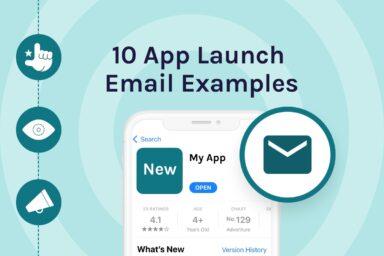How to successfully launch in app stores?
If you want to make money with the app you’ve developed or are adding an app to your already existing business as another UA channel, you need to publish your app in app stores. There really is no other way to distribute it.

Now, it’s rather common to heavily invest in building an app. And it’s as common to neglect to invest in app marketing. After an arguably stressful app development process, you might think that the hardest part is over, but truth to be told – app stores aren’t an easy place to make money anymore.
As an Android developer, you’re about to be one of the 100,000 app developers a month launching your app in Google Play Store. In the Apple App Store, you’re among approx. 30,000 app developers like you. Needless to say, it isn’t that easy to stand out. Let’s discuss what you can do to increase your app visibility for a successful launch in app stores.
Which app stores to launch in?
There are more than 300 app stores to distribute your mobile app. To get started, the Google Play Store and the Apple App Store are the two largest app distribution channels for your mobile apps. Together, they offer global coverage to more than a hundred countries and iOS and Android users.
For many app developers, there is the question of whether to launch on iOS or Android app stores or both? This is heavily dependent on the size of your plan. Is this a side project, or are you building an app business? Do you have the skills and resources for doing and maintaining both platforms? If it’s your first time launching an app, you may want to start with one platform to test your users’ behavior and to have easier app management at the start.
Why launch on Google Play Store or Apple App Store?
As of the third quarter of 2020, global consumer spending on Apple App Store amounted to 19 billion and 10.3 billion U.S. dollars on the Google Play Store. That is a big enough reason to use those platforms for your app distribution. But here’s a couple of (dis)advantages about both stores further.
Google Play Store has an easy approval process, compared to Apple App Store. It takes a few hours after submitting your app to Google, as long as you’ve done it according to their guidelines. In the Apple App Store case, 40% of apps are rejected during their first submission. Apple tests and analyzes for any bugs, broken links, false screenshots, repeated submission of similar apps, placeholder content, etc.
Google Play is better for testing your creatives. It allows the app to be more easily localized as you can filter creatives that are effective for a certain region and those that are not. Currently, the Apple App Store doesn’t have a testing feature.
However, Apple users spend more on apps than Android users do. Therefore, the Apple App Store has a higher probability of providing you with better user monetization.
One clear reason that speaks against choosing only one store among the two is that you’d be losing all of the other store users. Only Android users can use Android apps, and only iOS users can use iOS apps. Therefore, when your app is shared via social media or word of mouth, it won’t be that effective since people using a phone with another operating system won’t be able to access it.
Dive Deeper:
Submitting Android Apps to Google Play Store
Launching iOS Apps in the Apple App Store
Prepare your app marketing before the app store launch
Once you’ve decided to publish your app in app stores and you’ve chosen a suitable platform, you need to make sure that your app will also be found in app stores. Surely “just” listing your app in app stores might be one option on your mind. But to increase your chances of success, we’d highly recommend being proactive in your app marketing.
For successful app marketing, there are many aspects to be considered. Your strategy needs to include the basics like a name for your app and a branding plan for various channels where your ideal app users can be found. But also app creatives and keywords that describe your app the best and that match with the search terms that your users are really using.
And how to make sure people find out about your mobile app on time? Well, you need to start promoting it before it’s live.
Start with knowing your app’s audience
Knowing your app’s audience is key to successful app marketing. It’s the basis for appropriately segmenting and appealing to your future users. So start with the who and why. Who is your audience, and why do they need your solution? The chances are that you already know this because, during your app development phase, you’ve researched your audience well enough. To stress here, however, don’t focus only on the app features your audience wants. But make sure to know where to find them and how to sell to them.
Additionally, your app’s audience needs to be big enough to build a profitable app business. Targeting a very niche user base will show up in your app marketing very fast: simply because the search volume in app stores won’t be high enough for generating the desired amount of downloads.
Use app stores for your competitor research
Researching your competition is important for understanding what you’re up against. Luckily, you’re in the business of making apps, and therefore this research is relatively simple. Just go to app stores, search for solutions like yours, and see which apps show up. You can easily explore all of the existing competitors in the category that you’re launching in.
You see, thanks to app store listings being public information, you have access to a great amount of competitor data. You just need to know how to use it. So here are key things you can find from your competitors’ app store listing:
- Their pricing;
- Their customer satisfaction (ratings & reviews);
- Their user base and revenue (app installs);
- Are your competitors keeping their apps up to date (app store updates);
- Keywords they rank for (how do their users find them);
- Their branding (app name, creatives, and texts);
- Countries they focus on (localization and featurings);
- The advertising they do (app store ads);
As highlighted above, you can know a lot about your competitors for iOS and Android. You can easily set up regular tracking for this data (and more) with a free ASO tool like App Radar. So you’ll always know what your competition is up to.
Dive Deeper:
5 Essential Factors in Competitor Analysis for Mobile Apps
Benefit from omnichannel app marketing before the app store launch
App stores are limited in their marketing activities. Hence you can use other marketing channels to drive traffic towards your app store listing. When marketing your app on any of the channels mentioned below, follow this simple logic:
- Have clear call-to-actions (CTAs);
- Ask your audience what you want them to do (to install and review your app);
- Share benefits, not features.
Your website
Your website is, in most cases, the face of your business but also another marketing channel. Search Engine Optimization (SEO) is continuously a cost-effective way to attract organic traffic. It’ll also be a backlink for your app store page which has a big impact on Google Play Store rankings.
And, your website is a great way to build a mailing list of interested users before you’ve published your app. It helps you to generate a group of users interested in beta testing your app and who can be used as the first reviewers of your app.
Dive Deeper:
How Backlinks and SEO Affect App Visibility
Social media marketing
Prior to your app launch, you’ll want to connect with people who would use your app. You can do this by being active in social media. Use your social presence to generate interest and keep potential customers updated on when your product will be available. You can also use social media to drive more traffic to your website to sign up for your mailing list.
Dive Deeper:
7 ways to leverage social media to grow your mobile apps
Influencer marketing
Building relationships with influencers as direct outreach is another approach you can try as part of your app marketing. Before simply asking them to share your content, you could try to catch their attention by following and commenting on their social media first.
Dive Deeper:
Using influencer marketing to grow mobile games and apps
Great app store marketing will bring the success
Needless to say, every step of your UA funnel loses a certain amount of users. Hence, it’s highly important to ensure that the app stores’ user journey is fully optimized to increase your conversion rates and bring that download home.
In other words, you want your app store listing to show up in the right search results at the right time to the right people. And you also want to make sure that your store listing manages your future users’ expectations. That is, it doesn’t overpromise but tells clearly what the user will get from the app so that they don’t uninstall it a couple of minutes after downloading it.
Rank high in search results with a great app store listing
Now, ranking high in search results is important for getting the first funnel step correct: your app impressions. In the Apple App Store, 70% of visitors use search to find apps. And you want to make a good impression so that it turns into a store view (second funnel step). This way, the visitor has arrived on your landing page in app stores – your app store listing. Now you want him/her to take the last step of the UA funnel and download your app.
As you can see, all your marketing efforts will be directing your potential users to your app store listing. And therefore, when it comes to app store marketing, everything is one way or another connected to that listing.
The main impact factors that influence rankings are:
- Keyword usage in your app store listing;
- App creatives – icon, screenshots, and video;
- The number of downloads;
- The number of positive reviews and ratings.
The “art” of creating an app store listing that will make you rank high in search results is called App Store Optimization. And it’s important to practice it as a regular process: trying out different keywords, adjusting the texts from time to time, and using new app creatives frequently. You will need to apply different app marketing strategies for Google Play Store optimization and Apple App Store optimization.
Dive Deeper:
Ultimate Guide to ASO in 2022
App Store Ranking Factors: App Store vs. Google Play
Get your keywords right from the start
Keyword research is a very important part of your app store marketing. Simply because using the right search terms in your app store listing is the basis for showing up in search results. Furthermore, keywords are also used for running app store ads, and you wouldn’t want to be wasting your media budget.
There are five main ways to do keyword research: brainstorming (think of the words that you would expect people to search for to find your app); checking keyword rankings of competitors; using auto-complete searches in app stores to see which keywords show up frequently; signing up for free keyword research tool to analyze keywords by their search volume and difficulty; taking advantage of ASO tools with Keyword Finder feature (AI-based keyword recommendations).
Dive Deeper:
Researching App Keywords
App store creatives
Whether it’s email marketing, press releases, social media, or app stores, your app’s visual representation will help catch attention and tell a story. According to Splitmetrics study in 2020, app store creatives can have the greatest impact (around 20%) on your conversion. In short:
- Make your app icon stand out (it’s your first visual representation of your app store listing, you don’t want app store visitors to just scroll over it);
- Create relevant app creatives (connected to the solution your app offers);
- Consider the differences between the Apple App Store and Google Play Store (autoplay of video, amount of screenshots, etc.);
- Demonstrate the key message in the first screenshot (people only stay on the app store page for approx. 7 seconds);
- Localize your graphics (to remove a language barrier and make it easier for users to understand the features of the app);
- Use the option to upload app store video to give a real user experience.
Dive Deeper:
Differences for app store videos on Google Play Store and Apple App Store
Using App Store Listing Visuals to Make a Good First Impression
Use app store ads to boost your app store launch
Both app stores, Apple and Google, offer the opportunity to present ads to their store visitors. However, as mentioned, the viewers of your app store ads will land on your app store listing like with every other marketing channel. So make sure that your app store listing and ads are aligned.
Thinking forward, just like with every paid user acquisition channel, it’ll be important to track from the start where your ad budget is spent and where it has the highest return.
Dive Deeper:
How Does Google UAC Work?
Get expert support for your app store marketing
App developers usually do not have the knowledge, or simply the interest, to analyze and optimize their app store listings, regularly try out new creative elements, or make metadata updates. So sometimes it’s wiser to work closely with marketing specialists to secure a successful launch.
Reach out to our experienced team so that together we can make your app discovered in the app stores!
Testing your app before publishing in app stores
There are several ways you can test your app’s usability as well as app store presence before making your app available for everybody.
Invite-only beta launch
App developers can offer an invite-only beta version of their app to a select group of users who can give valuable feedback. This is a smart way to ensure you are fully prepared for your app store launch day. It also increases the likelihood of success and decreases the chance of performance issues. Another benefit of invite-only beta testing is that you are rewarding a group of enthusiastic users by giving them exclusive access, which should help you get early reviews and ratings.
Soft launch in the app store
A soft launch is the release of a mobile app in a specific region. For example, you can launch your app in Germany to test your app’s functionality and app store presence there first. Does your app show up for keywords you want it to? Do the creatives look as catchy as planned? Does your app user acquisition funnel convert as well as you expected it to? You can significantly increase the likelihood of a successful app launch with testing.
Dive Deeper:
App Store Pre-Order
Google Play Pre-Registration
Summary of launching in app stores
To conclude, the most important parts of preparing your app store launch are:
- Get your app marketing going as early as possible;
- Focus on keyword research to rank high in search results and create app creatives with real features of your app to secure conversion;
- Do proper app store testing;
- Make sure you comply with the app stores’ guidelines.

Latest Posts


